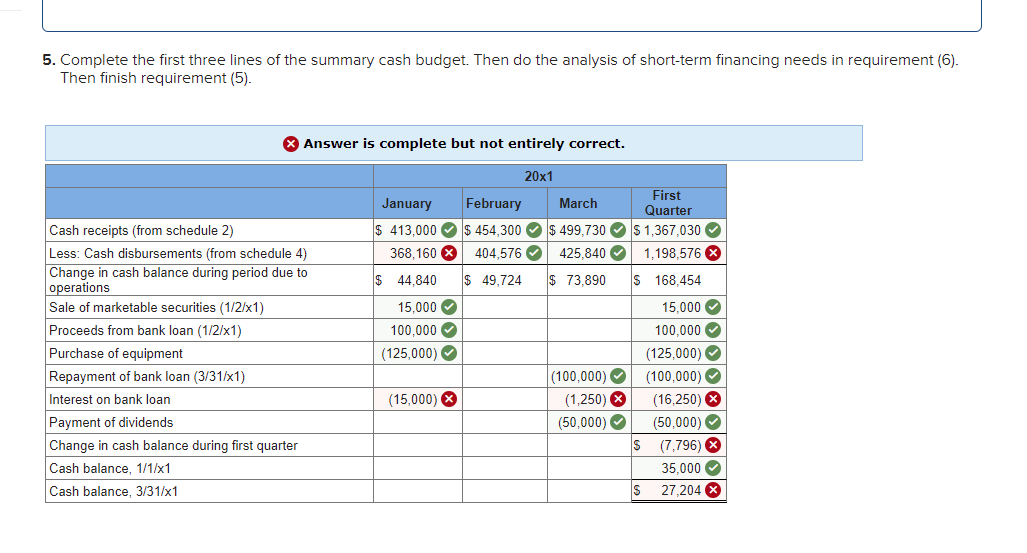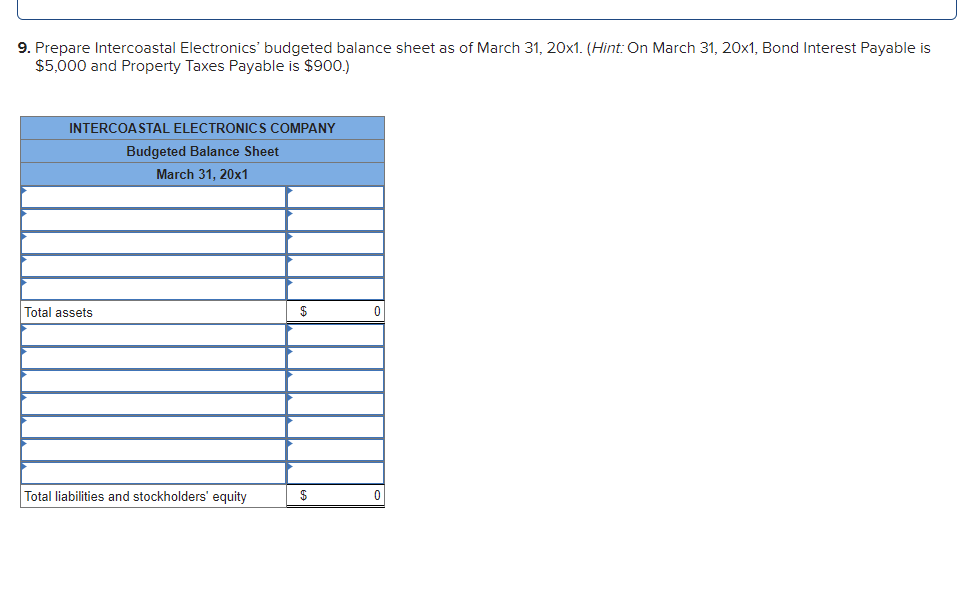Required information Skip to question [The following information applies to the questions displayed below.] “We really need to get this new material-handling equipment in operation just after the new year begins. I hope we can finance it largely with cash and marketable securities, but if necessary we can get a short-term loan down at MetroBank.” This statement by Beth Davies-Lowry, president of Intercoastal Electronics Company, concluded a meeting she had called with the firm’s top management. Intercoastal is a small, rapidly growing wholesaler of consumer electronic products. The firm’s main product lines are small kitchen appliances and power tools. Marcia Wilcox, Intercoastal’s General Manager of Marketing, has recently completed a sales forecast. She believes the company’s sales during the first quarter of 20x1 will increase by 10 percent each month over the previous month’s sales. Then Wilcox expects sales to remain constant for several months. Intercoastal’s projected balance sheet as of December 31, 20x0, is as follows: Cash $ 35,000 Accounts receivable 270,000 Marketable securities 15,000 Inventory 154,000 Buildings and equipment (net of accumulated depreciation) 626,000 Total assets $ 1,100,000 Accounts payable $ 176,400 Bond interest payable 12,500 Property taxes payable 3,600 Bonds payable (10%; due in 20x6) 300,000 Common stock 500,000 Retained earnings 107,500 Total liabilities and stockholders’ equity $ 1,100,000 Jack Hanson, the assistant controller, is now preparing a monthly budget for the first quarter of 20x1. In the process, the following information has been accumulated: Projected sales for December of 20x0 are $400,000. Credit sales typically are 75 percent of total sales. Intercoastal’s credit experience indicates that 10 percent of the credit sales are collected during the month of sale, and the remainder are collected during the following month. Intercoastal’s cost of goods sold generally runs at 70 percent of sales. Inventory is purchased on account, and 40 percent of each month’s purchases are paid during the month of purchase. The remainder is paid during the following month. In order to have adequate stocks of inventory on hand, the firm attempts to have inventory at the end of each month equal to half of the next month’s projected cost of goods sold. Hanson has estimated that Intercoastal’s other monthly expenses will be as follows: Sales salaries $ 21,000 Advertising and promotion 16,000 Administrative salaries 21,000 Depreciation 25,000 Interest on bonds 2,500 Property taxes 900 In addition, sales commissions run at the rate of 1 percent of sales. Intercoastal’s president, Davies-Lowry, has indicated that the firm should invest $125,000 in an automated inventory-handling system to control the movement of inventory in the firm’s warehouse just after the new year begins. These equipment purchases will be financed primarily from the firm’s cash and marketable securities. However, Davies-Lowry believes that Intercoastal needs to keep a minimum cash balance of $25,000. If necessary, the remainder of the equipment purchases will be financed using short-term credit from a local bank. The minimum period for such a loan is three months. Hanson believes short-term interest rates will be 10 percent per year at the time of the equipment purchases. If a loan is necessary, Davies-Lowry has decided it should be paid off by the end of the first quarter if possible. Intercoastal’s board of directors has indicated an intention to declare and pay dividends of $50,000 on the last day of each quarter. The interest on any short-term borrowing will be paid when the loan is repaid. Interest on Intercoastal’s bonds is paid semiannually on January 31 and July 31 for the preceding six-month period. Property taxes are paid semiannually on February 28 and August 31 for the preceding six-month period. Required: Complete the first three lines of the summary cash budget. Then do the analysis of short-term financing needs in requirement (6). Then finish requirement (5). 2. Prepare Intercoastal Electronics’ budgeted statement of retained earnings for the first quarter of 20x1. 3. Prepare Intercoastal Electronics’ budgeted balance sheet as of March 31, 20x1. (Hint: On March 31, 20x1, Bond Interest Payable is $5,000 and Property Taxes Payable is $900.)
Required information
Skip to question
[The following information applies to the questions displayed below.]
“We really need to get this new material-handling equipment in operation just after the new year begins. I hope we can finance it largely with cash and marketable securities, but if necessary we can get a short-term loan down at MetroBank.” This statement by Beth Davies-Lowry, president of Intercoastal Electronics Company, concluded a meeting she had called with the firm’s top management. Intercoastal is a small, rapidly growing wholesaler of consumer electronic products. The firm’s main product lines are small kitchen appliances and power tools. Marcia Wilcox, Intercoastal’s General Manager of Marketing, has recently completed a sales
| Cash | $ | 35,000 | |
| 270,000 | |||
| Marketable securities | 15,000 | ||
| Inventory | 154,000 | ||
| Buildings and equipment (net of accumulated |
626,000 | ||
| Total assets | $ | 1,100,000 | |
| Accounts payable | $ | 176,400 | |
| Bond interest payable | 12,500 | ||
| Property taxes payable | 3,600 | ||
| Bonds payable (10%; due in 20x6) | 300,000 | ||
| Common stock | 500,000 | ||
| 107,500 | |||
| Total liabilities and |
$ | 1,100,000 | |
Jack Hanson, the assistant controller, is now preparing a monthly budget for the first quarter of 20x1. In the process, the following information has been accumulated:
-
Projected sales for December of 20x0 are $400,000. Credit sales typically are 75 percent of total sales. Intercoastal’s credit experience indicates that 10 percent of the credit sales are collected during the month of sale, and the remainder are collected during the following month.
-
Intercoastal’s cost of goods sold generally runs at 70 percent of sales. Inventory is purchased on account, and 40 percent of each month’s purchases are paid during the month of purchase. The remainder is paid during the following month. In order to have adequate stocks of inventory on hand, the firm attempts to have inventory at the end of each month equal to half of the next month’s projected cost of goods sold.
-
Hanson has estimated that Intercoastal’s other monthly expenses will be as follows:
Sales salaries $ 21,000 Advertising and promotion 16,000 Administrative salaries 21,000 Depreciation 25,000 Interest on bonds 2,500 Property taxes 900 In addition, sales commissions run at the rate of 1 percent of sales.
-
Intercoastal’s president, Davies-Lowry, has indicated that the firm should invest $125,000 in an automated inventory-handling system to control the movement of inventory in the firm’s warehouse just after the new year begins. These equipment purchases will be financed primarily from the firm’s cash and marketable securities. However, Davies-Lowry believes that Intercoastal needs to keep a minimum cash balance of $25,000. If necessary, the remainder of the equipment purchases will be financed using short-term credit from a local bank. The minimum period for such a loan is three months. Hanson believes short-term interest rates will be 10 percent per year at the time of the equipment purchases. If a loan is necessary, Davies-Lowry has decided it should be paid off by the end of the first quarter if possible.
-
Intercoastal’s board of directors has indicated an intention to declare and pay dividends of $50,000 on the last day of each quarter.
-
The interest on any short-term borrowing will be paid when the loan is repaid. Interest on Intercoastal’s bonds is paid semiannually on January 31 and July 31 for the preceding six-month period.
-
Property taxes are paid semiannually on February 28 and August 31 for the preceding six-month period.
Required:
-
Complete the first three lines of the summary
cash budget . Then do the analysis of short-term financing needs in requirement (6). Then finish requirement (5).
2. Prepare Intercoastal Electronics’ budgeted statement of retained earnings for the first quarter of 20x1.
3. Prepare Intercoastal Electronics’ budgeted balance sheet as of March 31, 20x1. (Hint: On March 31, 20x1, Bond Interest Payable is $5,000 and Property Taxes Payable is $900.)


Trending now
This is a popular solution!
Step by step
Solved in 3 steps







